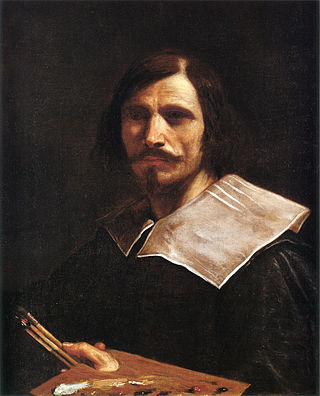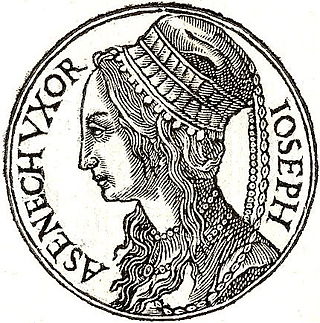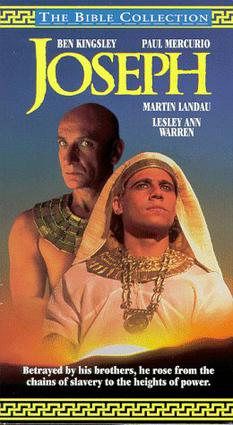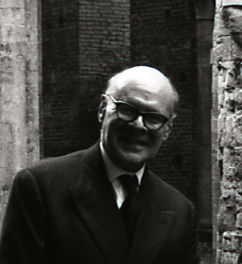
Jacob, later given the name Israel, is regarded as a patriarch of the Israelites and is an important figure in Abrahamic religions, such as Judaism, Christianity, and Islam. Jacob first appears in the Book of Genesis, where he is described as the son of Isaac and Rebecca, and the grandson of Abraham, Sarah, and Bethuel. According to the biblical account, he was the second-born of Isaac's children, the elder being Jacob's fraternal twin brother, Esau. Jacob is said to have bought Esau's birthright and, with his mother's help, deceived his aging father to bless him instead of Esau. Later in the narrative, following a severe drought in his homeland of Canaan, Jacob and his descendants, with the help of his son Joseph, moved to Egypt where Jacob died at the age of 147. He is supposed to have been buried in the Cave of Machpelah.

According to the Hebrew Bible, the Tribe of Ephraim was one of the tribes of Israel. The Tribe of Manasseh together with Ephraim formed the House of Joseph. It is one of the ten lost tribes. The etymology of the name is disputed.

According to the Hebrew Bible, the Tribe of Manasseh was one of the Tribes of Israel. It is one of the ten lost tribes. Together with the Tribe of Ephraim, Manasseh also formed the House of Joseph.

Giovanni Francesco Barbieri, better known as Guercino, or il Guercino[ɡwerˈtʃiːno], was an Italian Baroque painter and draftsman from Cento in the Emilia region, who was active in Rome and Bologna. The vigorous naturalism of his early manner contrasts with the classical equilibrium of his later works. His many drawings are noted for their luminosity and lively style.

The Tribe of Joseph is one of the Tribes of Israel in biblical tradition. Since Ephraim and Manasseh together traditionally constituted the tribe of Joseph, it was often not listed as one of the tribes, in favour of Ephraim and Manasseh being listed in its place; consequently it was often termed the House of Joseph, to avoid the use of the term tribe. According to the Targum Pseudo-Jonathan, the ensign of both the House of Joseph and the Tribe of Benjamin was of silk of three colours, corresponding with the precious stones in the priestly breastplate, leshem, shavo, and aḥlamah; and upon it expressed and set forth the names of the three tribes, Ephraim, Manasseh and Benjamin; having the figure of a young man upon it, with the inscription: "And the Cloud of the LORD was over them by day, when they set forward from the camp.". There were obvious linguistic differences between at least one portion of Joseph and the other Israelite tribes. At the time when Ephraim were at war with the Israelites of Gilead, under the leadership of Jephthah, the pronunciation of shibboleth as sibboleth was considered sufficient evidence to single out individuals from Ephraim, so that they could be subjected to immediate death by the Israelites of Gilead.
In the Latter Day Saint movement, a patriarchal blessing is an ordinance administered by the laying on of hands, with accompanying words of promise, counsel, and lifelong guidance intended solely for the recipient. The words, inspired by the Holy Ghost, are spoken by the patriarch (evangelist) performing the ordinance. Patriarchal blessings are available to baptized church members upon their request. While other blessings of comfort, healing, and guidance can be received by the laying on of hands at any time throughout a person's life, a Patriarchal blessing is unique in that:

Ephraim was, according to the Book of Genesis, the second son of Joseph ben Jacob and Asenath. Asenath was an Ancient Egyptian woman whom Pharaoh gave to Joseph as wife, and the daughter of Potipherah, a priest of ʾĀwen. Ephraim was born in Egypt before the arrival of the Israelites from Canaan.

Asenath is a minor figure in the Book of Genesis. Asenath was a high-born, aristocratic Egyptian woman. She was the wife of Joseph and the mother of his sons, Manasseh and Ephraim. There are two Rabbinic approaches to Asenath: One holds that she was an ethnic Egyptian woman that converted to marry Joseph. This view has her accepting the Lord before marriage and then raising her two sons in the tenets of Judaism. This presents her as a positive example of conversion, and places her among the devout women converts. The other approach argues she was not Egyptian by descent, but was from the family of Jacob. Traditions that trace her to the family of Jacob relate that she was born as the daughter of Dinah. Dinah was raped by Shechem and gave birth to Asenath, whom Jacob left on the wall of Egypt, where she was later found by Potiphar. She was then raised by Potiphar's wife and eventually married Joseph.
The House of Joseph is a designation which members of the Church of Jesus Christ of Latter-day Saints apply to the ancient "birthright" tribe of the house of Israel (Jacob) as it is described in the Old Testament, made up of the tribes of Ephraim and Manasseh. The tribes' namesakes — the two sons of Joseph of Egypt — are first mentioned in Genesis 41:50-52.

The National Gallery of Ireland houses the national collection of Irish and European art. It is located in the centre of Dublin with one entrance on Merrion Square, beside Leinster House, and another on Clare Street. It was founded in 1854 and opened its doors ten years later. The gallery has an extensive, representative collection of Irish paintings and is also notable for its Italian Baroque and Dutch masters painting. The current director is Caroline Campbell.

The Twelve Tribes of Israel are, according to Hebrew scriptures, the descendants of the biblical patriarch Jacob, also known as Israel, through his twelve sons through his wives, Leah and Rachel, and his concubines, Bilhah and Zilpah, who collectively form the Israelite nation. In modern scholarship, there is skepticism as to whether there ever were twelve Israelite tribes, with the use of the number 12 thought more likely to signify a symbolic tradition as part of a national founding myth.

Giovanni Lanfranco was an Italian painter of the Baroque period.
Carlo Bononi was an Italian painter.

The Bible: Joseph is a 1995 German/Italian/American television miniseries about the life of Joseph from the Old Testament. It aired on TNT and was filmed in Morocco.

Sir John Denis Mahon, was a British collector and historian of Italian art. Considered to be one of the few art collectors who was also a respected scholar, he is generally credited, alongside Sacheverell Sitwell and Tancred Borenius, with bringing Italian pre-Baroque and Baroque painters to the attention of English-speaking audiences, reversing the critical aversion to their work that had prevailed from the time of John Ruskin.

Manasseh or Menashe was, according to the Book of Genesis, the first son of Joseph and Asenath. Asenath was an Egyptian woman whom the Pharaoh gave to Joseph as wife, and the daughter of Potipherah, a priest of On. Manasseh was born in Egypt before the arrival of the children of Israel from Canaan.

Giulio Cesare Sacchetti was an Italian Catholic Cardinal and was twice included in the French Court's list of acceptable candidates for the Papacy, in 1644 and 1655.

Jacob Blessing the Sons of Joseph is a 1656 oil painting by Dutch artist Rembrandt van Rijn. It is said to have almost “a sculptural surface with a translucent glaze over paint”. This piece is housed in the Gemäldegalerie Alte Meister in Kassel, Germany. The painting was commissioned by the Amsterdam patrician Willem Schrijver. It shows him with his wife Wendela de Graeff and their children as biblical figures.

Abraham Casting out Hagar and Ishmael is a 1657 oil on canvas painting by Guercino, commissioned from him by the town of Cento to present to cardinal Lorenzo Imperiali, papal legate in Ferrara. It hangs now in the Pinacoteca di Brera in Milan.

The Martyrdom of Saint Catherine is a 1653 oil on canvas painting by Guercino, commissioned by Cento to present to cardinal Alderano Cibo, papal legate in Ferrara.














